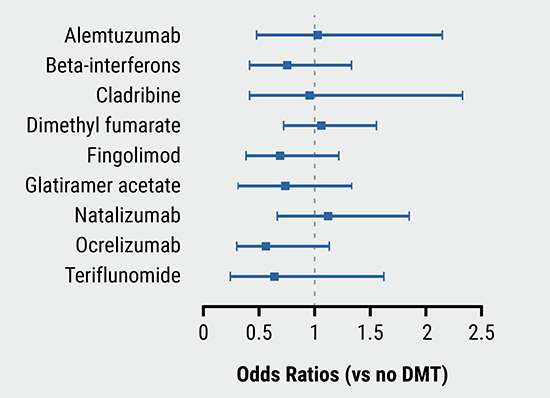https://doi.org/10.55788/8c8c6f36
What is known about the effectiveness of AHSCT in progressive MS mostly comes from results of studies that focused on relapsing-remitting MS. In fact, at ECTRIMS 2022, Prof. Tomas Kalincik (Royal Melbourne Hospital, Australia) presented results of a study comparing AHSCT with 3 high-efficacy DMTs in relapsing-remitting MS [1]. Prof. Kalincik also explored the effectiveness of AHSCT in progressive MS and compared it with a single, high-efficacy therapy, namely natalizumab [2]. This comparator was chosen for pragmatic reasons.
Patients with secondary or primary progressive MS (SPMS and PPMS) from 6 AHSCT MS centres around the world plus patients from the MSBase registry (msbase.org) could participate. They were included if they received AHSCT or started natalizumab during progressive MS. A total of 39 participants treated with AHSCT (37 with SPMS, 2 with PPMS) were matched with 139 natalizumab users. The pairwise-censored groups were compared on annualised relapse rates (ARR), freedom from relapses, and cumulative hazards of 6-months confirmed Expanded Disability Status Scale (EDSS) worsening and improvement. Prof. Kalincik stressed that, on average, participants had moderately advanced disease, with a mean EDSS of 5.7 and a mean 0.5–0.6 relapses in the preceding year. There was a follow-up of up to 6 years.
ARR while on treatment was low in both groups (both 0.08). “This is significant when we consider that these patients had a relatively high relapse rate prior to baseline,” Prof. Kalincik commented. Hazard ratio for relapses was 1.05 (see Figure), a result that was corroborated by the similar cumulative hazards of having a relapse at year 2 (AHSCT 20%, natalizumab 14%) and at year 5 (31% and 34%, respectively). Confirmed EDSS worsening was relatively prevalent in both groups (HR 1.49) and HR for improvement, which rarely occurred, was 1.49.
Figure: Relapse results for AHSCT and natalizumab [2]

In the AHSCT group, 3 patients (7.7%) had febrile neutropenia during mobilisation, 9 (23%) had serum sickness, 6 (15%) required ICU admission, and 36 (92%) experienced complications after discharge, including 21 infections. There were no treatment-related deaths.
- Kalincik T, et al. Comparative effectiveness of autologous haematopoietic stem cell transplantation vs. fingolimod, ocrelizumab and natalizumab in relapsing-remitting MS. Abstract O019, ECTRIMS 2022, 26–28 October, Amsterdam, the Netherlands.
- Kalincik T, et al. Effectiveness of autologous haematopoietic stem cell transplantation in comparison with natalizumab in progressive MS. Abstract O181, ECTRIMS 2022, 26–28 October, Amsterdam, the Netherlands.
Copyright ©2022 Medicom Medical Publishers
Posted on
Previous Article
« Efficacy of DMTs fades away in secondary progressive MS Next Article
Switching treatment after initial platform injectable DMT: real-world data »
« Efficacy of DMTs fades away in secondary progressive MS Next Article
Switching treatment after initial platform injectable DMT: real-world data »
Table of Contents: ECTRIMS 2022
Featured articles
Letter from the Editor
Diagnosis and Prediction of Disease Course
A case for including optic nerve lesions in the McDonald criteria
Cerebrospinal fluid kappa-free light chains for MS diagnosis
Early, non-disabling relapses increase disability accumulation
Physical impairment is present before perceived MS onset
Chronic active MS lesions respond poorly to anti-CD20 antibodies
Treatment: Trials & Strategies
Dimethyl fumarate reduces the risk of a first clinical event in RIS
How and when to make a timely switch to high-efficacy DMT
Comparing real-world effectiveness of DMTs
Study fails to show non-inferiority of rituximab to ocrelizumab
Autologous haematopoietic stem cell transplantation versus DMTs
Progressive MS
Stem cell transplantation not superior to natalizumab in progressive MS
Efficacy of DMTs fades away in secondary progressive MS
Smartphone tapping can help detect progressive MS
Paediatric MS
Early treatment with DMT effective in paediatric-onset MS
Fingolimod in paediatric MS: results of up to 6 years
Switching treatment after initial platform injectable DMT: real-world data
Pregnancy
Pregnancy and infant outcomes in women receiving ocrelizumab
New safety data of anti-CD20 mAbs around pregnancy
MS activity and pregnancy outcomes after long-term use of natalizumab
NMOSD
Ravulizumab significantly reduced relapses in AQP4+ NMOSD
NMOSD patients are cognitively impaired regardless of serostatus
Evidence-based consensus on pregnancy in NMOSD
COVID-19
COVID-19 and MS: lessons learned thus far
Ocrelizumab and fingolimod increase the risk of COVID-19 and of worse outcomes
Humoral and cellular immune responses after SARS-CoV-2 vaccination
Miscellaneous
Re-myelination strategies in MS still pose many unanswered questions
MS associated with a broader Epstein-Barr virus specific T-cell receptor repertoire
Cognitive rehab and mindfulness reduce cognitive complaints in MS
Related Articles
December 20, 2022
Study fails to show non-inferiority of rituximab to ocrelizumab
August 18, 2021
Machine-learning method accurately classifies patients with MS

November 25, 2020
Risk of COVID-19 not increased in MS patients
© 2024 Medicom Medical Publishers. All rights reserved. Terms and Conditions | Privacy Policy
HEAD OFFICE
Laarderhoogtweg 25
1101 EB Amsterdam
The Netherlands
T: +31 85 4012 560
E: publishers@medicom-publishers.com

